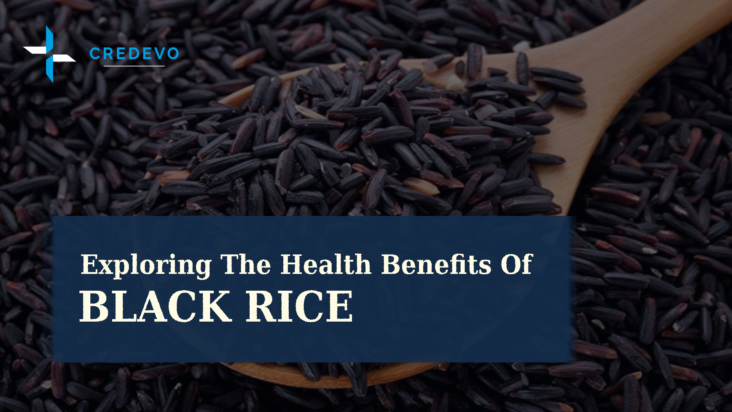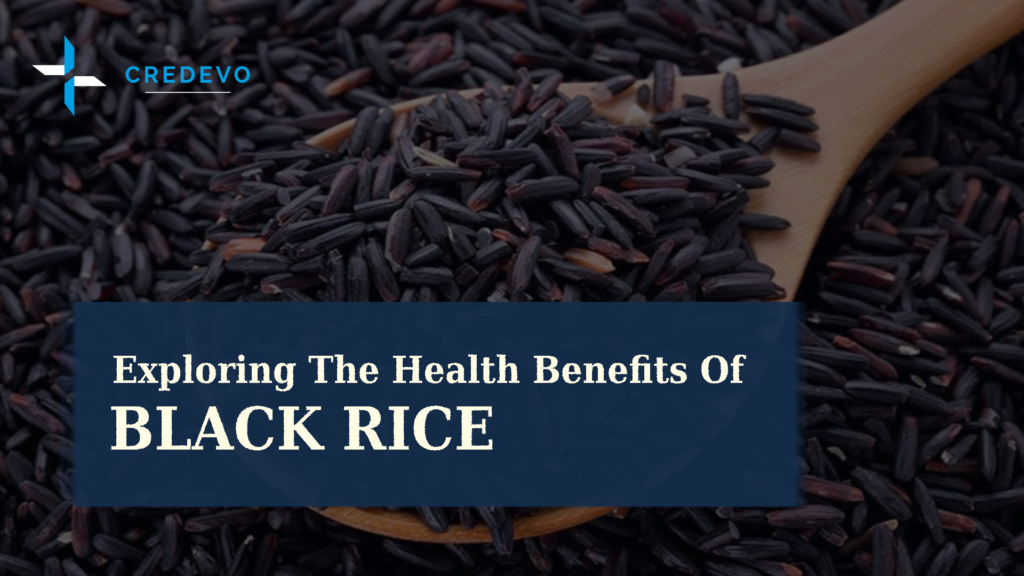Exploring The Health Benefits Of Black Rice: A Comprehensive Guide

Black rice, also known as forbidden rice or purple rice, is a lesser-known variety of rice that has been gaining popularity in recent years due to its impressive health benefits and unique culinary properties. Originating from regions such as Asia, particularly China, and India, black rice has a rich history dating back thousands of years, where it was once reserved exclusively for royalty and nobility, earning its “forbidden” moniker.

Unlike traditional white or brown rice, black rice boasts a striking dark purple hue, which is attributed to its high levels of anthocyanins, powerful antioxidants also found in foods like blueberries and purple grapes. This distinctive color not only adds visual appeal to dishes but also serves as an indicator of its exceptional nutritional value.
In this article, we will delve into the nutritional profile of black rice, explore its potential health benefits, discuss its culinary versatility, and provide tips on incorporating this ancient grain into your diet.
Nutritional Profile of Black Rice
The nutritional profile of black rice is impressive, offering a range of essential nutrients.
Here’s a summary of its key nutritional components:
- Carbohydrates: Like other rice varieties, black rice primarily consists of carbohydrates, which serve as the body’s main source of energy.
- Fiber: Black rice is notably high in dietary fiber, particularly insoluble fiber, which aids digestion, promotes bowel regularity, and helps prevent constipation.
- Protein: Black rice contains a moderate amount of protein, making it a suitable option for vegetarians and vegans looking to increase their protein intake.
- Antioxidants: One of the most remarkable features of black rice is its high antioxidant content, primarily due to its abundance of anthocyanins. These potent antioxidants help neutralize harmful free radicals in the body, reducing the risk of chronic diseases such as heart disease, cancer, and diabetes.
- Vitamins and Minerals: Black rice contains various vitamins and minerals essential for overall health, including vitamin E, which supports immune function and skin health, and minerals like iron, zinc, and magnesium, which play vital roles in various bodily functions.
- Low Glycemic Index: Despite its carbohydrate content, black rice has a relatively low glycemic index (GI), meaning it causes a slower and steadier rise in blood sugar levels compared to other rice varieties. This makes it a suitable option for individuals monitoring their blood sugar levels, such as those with diabetes or insulin resistance.
Overall, black rice is a nutrient-dense grain that offers a range of health benefits beyond those provided by traditional white or brown rice. Incorporating black rice into your diet can help promote overall health and well-being, making it a valuable addition to any balanced diet.
What are the antioxidant properties of black rice?
Black rice is renowned for its exceptional antioxidant properties, primarily attributed to its high concentration of anthocyanins.
Here’s an overview of the antioxidant properties of black rice:
- Anthocyanins: Black rice owes its deep purple hue to its rich anthocyanin content. Anthocyanins are a type of flavonoid pigment with potent antioxidant properties. These compounds help neutralize harmful free radicals in the body, which can cause oxidative stress and damage to cells, proteins, and DNA. By scavenging free radicals, anthocyanins contribute to reducing inflammation, lowering the risk of chronic diseases, and supporting overall health.
- Polyphenols: In addition to anthocyanins, black rice contains various other polyphenolic compounds with antioxidant activity. Polyphenols are plant-based compounds known for their ability to combat oxidative stress and protect against age-related diseases. By inhibiting oxidative damage, polyphenols help maintain cellular health and promote longevity.
- Vitamin E: Black rice is a good source of vitamin E, a fat-soluble antioxidant that protects cell membranes from oxidative damage caused by free radicals. Vitamin E also plays a crucial role in immune function, skin health, and cellular repair processes.
- Ferulic Acid: Black rice contains ferulic acid, a phenolic compound with antioxidant and anti-inflammatory properties. Ferulic acid acts synergistically with other antioxidants to enhance their effectiveness and protect cells from oxidative damage.
- Carotenoids: While not as abundant as in orange or yellow fruits and vegetables, black rice also contains carotenoid antioxidants such as beta-carotene and lutein. These compounds contribute to eye health, skin protection, and immune function by scavenging free radicals and reducing oxidative stress.
Overall, the antioxidant properties of black rice make it a valuable addition to the diet for promoting health and preventing chronic diseases associated with oxidative damage. Incorporating black rice into meals can help boost antioxidant intake and support overall well-being.
What are the potential health benefits of black rice?
Black rice offers a range of potential health benefits due to its unique nutritional composition and antioxidant properties. Here are some of the key health benefits associated with consuming black rice:
- Heart Health: The antioxidants in black rice, particularly anthocyanins and polyphenols, have been linked to improved heart health by reducing inflammation, lowering LDL (bad) cholesterol levels, and protecting against oxidative stress. This may help lower the risk of heart disease, stroke, and other cardiovascular conditions.
- Cancer Prevention: The antioxidants and phytochemicals found in black rice have been shown to possess anti-cancer properties, inhibiting the growth and spread of cancer cells and reducing the risk of certain types of cancer, including breast, colon, and liver cancer.
- Digestive Health: Black rice is high in dietary fiber, which promotes digestive health by supporting regular bowel movements, preventing constipation, and maintaining a healthy balance of gut bacteria. Adequate fiber intake has also been associated with a reduced risk of digestive disorders such as diverticulosis and colon cancer.
- Weight Management: The fiber content of black rice helps promote feelings of fullness and satiety, which can aid in weight management by reducing overall calorie intake and preventing overeating. Additionally, black rice has a lower glycemic index compared to white rice, leading to slower digestion and a more stable blood sugar response, which may help control appetite and cravings.
- Diabetes Management: Black rice’s low glycemic index and high fiber content make it a suitable option for individuals with diabetes or those at risk of developing the condition. Consuming foods with a lower glycemic index can help regulate blood sugar levels and improve insulin sensitivity, reducing the risk of diabetes complications.
- Brain Health: The antioxidants and phytochemicals in black rice have been associated with improved cognitive function and brain health. These compounds help protect brain cells from oxidative damage and inflammation, potentially reducing the risk of neurodegenerative diseases such as Alzheimer’s and Parkinson’s disease.
- Skin Health: The antioxidants in black rice, particularly vitamin E and anthocyanins, contribute to skin health by protecting against oxidative damage from UV radiation, reducing inflammation, and promoting collagen production. This may help prevent premature aging, wrinkles, and skin damage caused by environmental factors.
Comparison of black with other Rice Varieties
Comparing black rice with other rice varieties can help highlight its unique nutritional profile and potential health benefits.
Here’s a comparison of black rice with white rice and brown rice:
| Aspect | Black Rice | White Rice | Brown Rice |
| Color & Appearance | Deep purple-black color, nutty flavor, slightly chewy texture | Polished appearance, mild flavor, soft texture | Light brown color, nutty flavor, chewy texture |
| Nutritional Content | Highest in antioxidants, fiber, vitamins, and minerals | Lowest in nutrients, refined and processed | Higher in fiber, vitamins, and minerals compared to white rice, lower in antioxidants compared to black rice |
| Glycemic Index | Lower glycemic index, slower blood sugar response | Higher glycemic index, rapid spikes in blood sugar | Lower glycemic index compared to white rice, may be slightly higher than black rice |
| Health Benefits | Superior antioxidant benefits, potentially reducing inflammation and lowering the risk of chronic diseases | Fewer nutrients and health benefits compared to black rice and brown rice | Healthier alternative to white rice, higher in fiber and nutrients, but may not offer the same antioxidant benefits as black rice |
Culinary Uses and Recipes
- Cooking Methods: Cook black rice using various methods such as boiling, steaming, and pressure cooking. Use it as a standalone dish or combine it with other ingredients in salads, stir-fries, soups, and stews.
- Side Dish: Serve black rice as a nutritious side dish alongside grilled vegetables, roasted meats, or seafood.
- Salads: Incorporate cooked black rice into salads for added texture, color, and nutritional value. Combine it with fresh vegetables, herbs, nuts, and a flavorful dressing for a vibrant salad.
- Stir-Fries: Use cooked black rice as a base for stir-fries with tofu, chicken, shrimp, or a variety of vegetables. Add soy sauce, ginger, garlic, and other seasonings for a delicious Asian-inspired dish.
- Desserts: Experiment with using black rice in sweet dishes such as puddings, rice cakes, or rice pudding. Combine cooked black rice with coconut milk, sweeteners like honey or maple syrup, and fruits for a satisfying dessert.
Storing Tips
- Dry Storage: Store uncooked black rice in an airtight container in a cool, dry place away from direct sunlight. Properly stored, black rice can last for up to one year.
- Refrigeration: Cooked black rice can be stored in the refrigerator for up to five days. Allow it to cool completely before transferring it to a sealed container.
- Freezing: Cooked black rice can also be frozen for longer-term storage. Divide it into portions and store them in airtight freezer bags or containers. Thaw and reheat as needed.
Precautions and Considerations
- Rinsing: Before cooking black rice, rinse it thoroughly under cold water to remove any excess starch and debris.
- Cooking Time: Black rice typically requires a longer cooking time compared to white rice or even brown rice. Follow the instructions on the package or adjust the cooking time accordingly.
- Natural Pigments: Be aware that the natural pigments in black rice may stain utensils, cookware, and surfaces. Use caution when handling and cooking black rice to avoid staining.
- Potential Allergens: Individuals with allergies to rice or gluten should exercise caution when consuming black rice and check product labels for potential cross-contamination.
By incorporating black rice into various dishes and following proper storing tips and precautions, you can enjoy its unique flavor, texture, and health benefits to the fullest.
Conclusion
In conclusion, integrating black rice into your diet is a flavorful and nutritious choice. With its rich antioxidants, fiber, and minerals, black rice offers various health benefits, from supporting heart health to aiding digestion. Whether as a side dish or in salads, stir-fries, or desserts, its versatility makes it easy to incorporate into your meals. Remember to rinse before cooking, adjust cooking times, and store properly. By adding black rice to your diet, you’re not only enjoying delicious meals but also nurturing your health.
Are you interested in learning more about black rice?
Are you seeking information on black rice, or do you require assistance with purchasing or business development related to black rice?